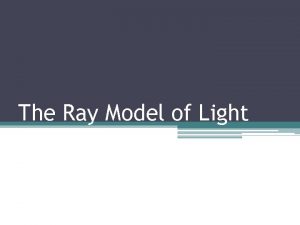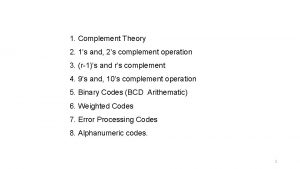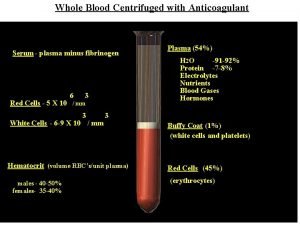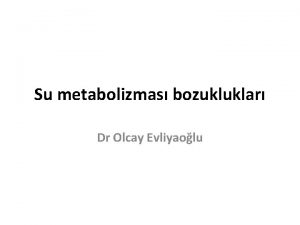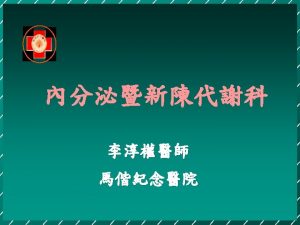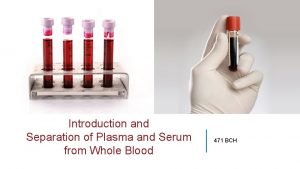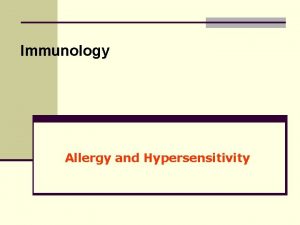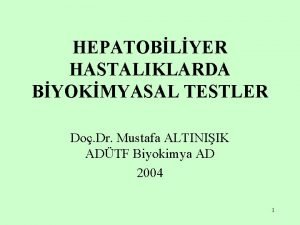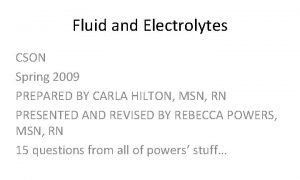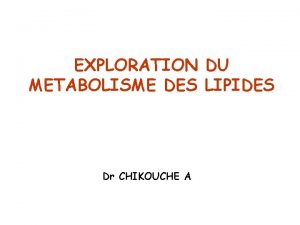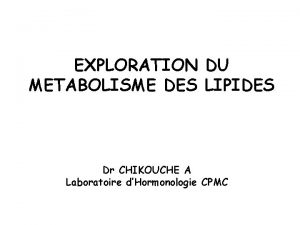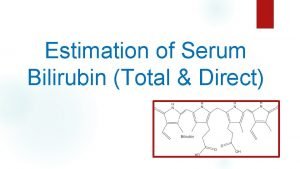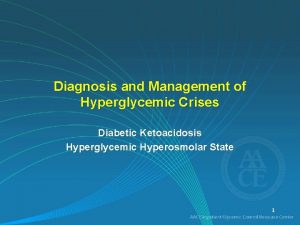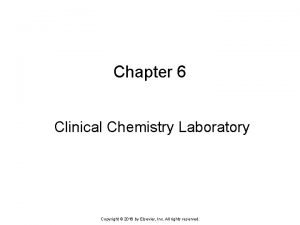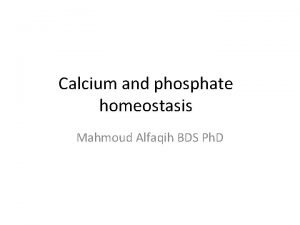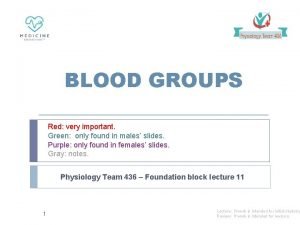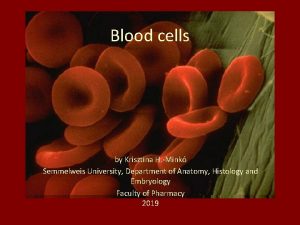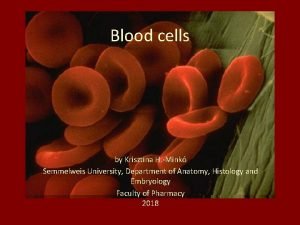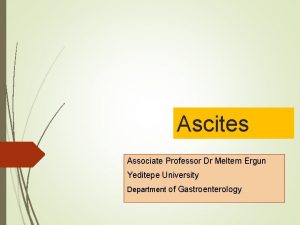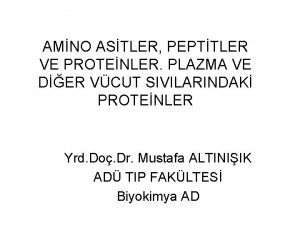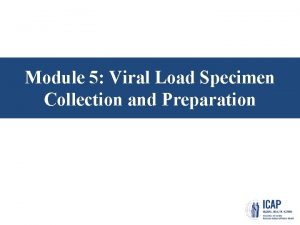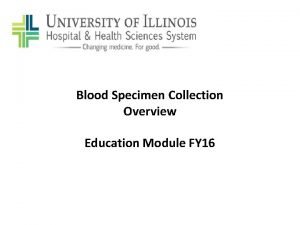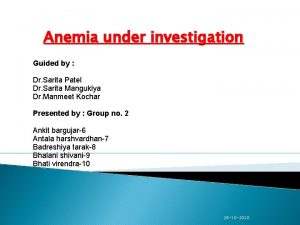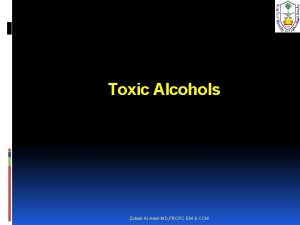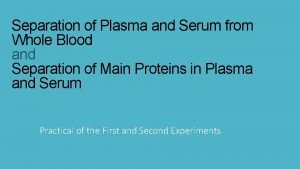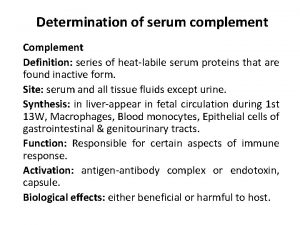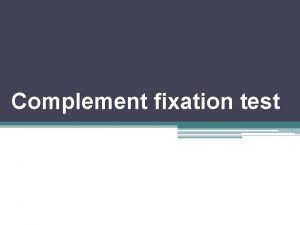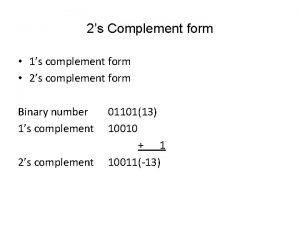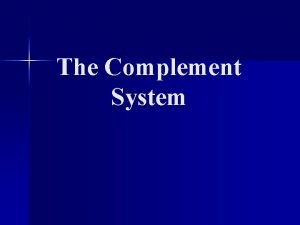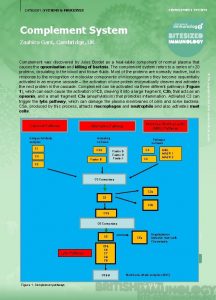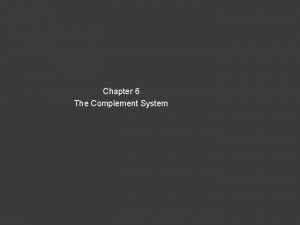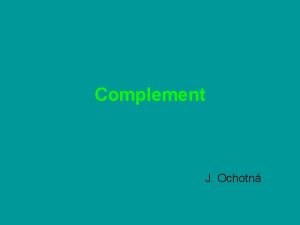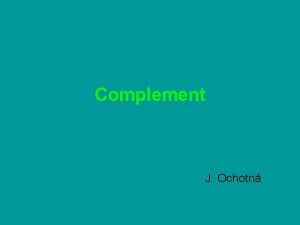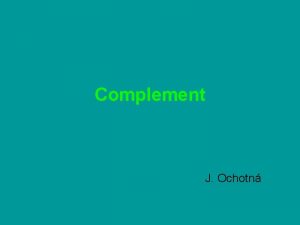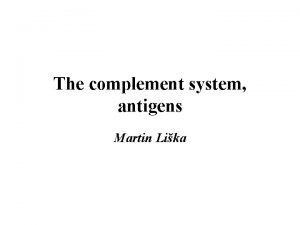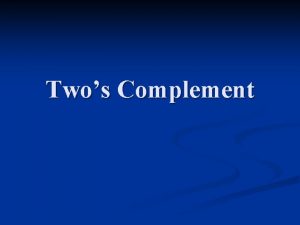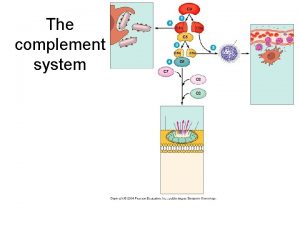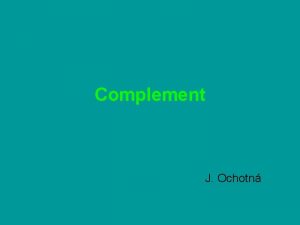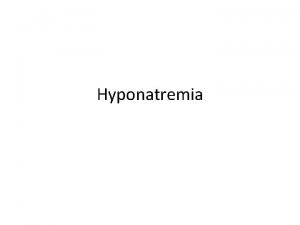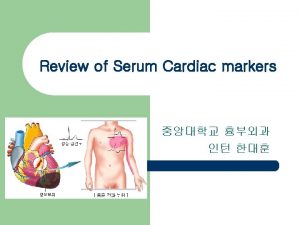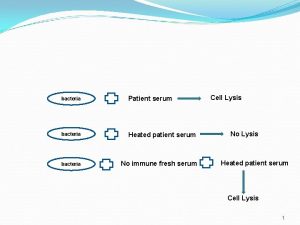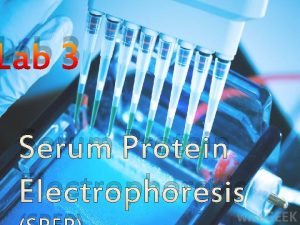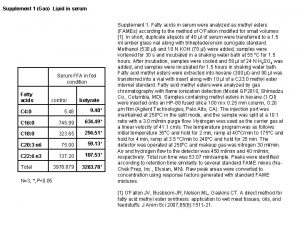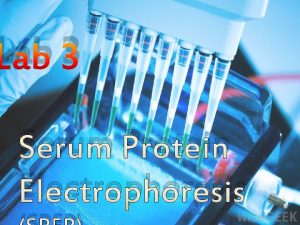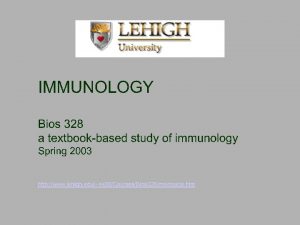Complement system Complement refers historically to fresh serum


































- Slides: 34

Complement system Complement refers, historically, to fresh serum capable of lysing antibody (Ab) coated cells. This activity is destroyed (inactivated) by heating serum at 56 degrees C for 30 minutes.

Proteins of the Complement System Complement system is composed of more than 25 produced by different Table 1), )different proteins tissues and cells including hepatocytes, . macrophages and gut epithelial cells These proteins are activated by a variety of agents and their activation proceeds in a cascade . fashion leading to lysis Consequently, an absence of one of the components in the pathway can disrupt the cascade and terminate the reaction.









PATHWAYS OF COMPLEMENT ACTIVATION The complement activation can be divided into three pathways: Classical pathway, Alternative pathway Membrane attack pathway Both classical and alternative pathways lead to the activation of C 5 convertase and result in the production of C 5 b which is essential for the activation of the membrane attack pathway.

Table 1. Proteins of the Complement system Classical Pathway Lectin Pathway Activation Mannan binding * Proteins: D, protein (MBP), C 1 qrs, C 2, C 3, C 4 Mannan-asociated Control Proteins: Serine Protease C 1 -INH, C 4 -BP (MASP, MASP 2) Alternative Pathway Lytic Pathway C 3, Factors B & C 5, C 6, C 7, C 8, Properdin C 9 Factors I* & Protein S H, DAF, CR 1, etc. Components underlined acquire enzymatic activity when activated. Components marked with an asterisk have enzymatic activity in their native form. DAF: decay accelerating factor

CLASSICAL PATHWAY Classical pathway normally requires: A suitable Ab bound to antigen (Ag) Complement components 1, 4, 2 and 3 Mg++ and Ca++ Cations C 1 activation Binding of C 1 qrs (a calcium-dependent complex), present in normal serum, to Ag-Ab complexes results in autocatalysis of C 1 r. The altered C 1 r cleaves C 1 s and this cleaved C 1 s becomes an enzyme (C 4 -C 2 convertase) capable of cleaving both C 4 and C 2.

C 4 and C 2 activation (generation of C 3 convertase) Activated C 1 s enzymatically cleaves C 4 into C 4 a and C 4 b binds to the Ag-bearing particle or cell membrane while C 4 a remains a biologically active peptide at the reaction site. C 4 b binds C 2 which becomes susceptible to C 1 s and is cleaved into C 2 a and C 2 b. C 2 a remains complexed with C 4 b whereas C 2 b is released in the micro environment. C 4 b 2 a complex, is known as C 3 convertase in which C 2 a is the enzymatic moiety.

C 3 activation (generation of C 5 convertase) C 3 convertase, in the presence of Mg++, cleaves C 3 into C 3 a and C 3 b binds to the membrane to form C 4 b 2 a 3 b complex whereas C 3 a remains in the micro environment. C 4 b 2 a 3 b complex functions as C 5 convertase which cleaves C 5 into C 5 a and C 5 b. Generation of C 5 convertase marks the end of the classical pathway.

Activation of C 3 by the classical pathway

LECTIN PATHWAY C 4 activation can be achieved without antibody and C 1 participation by the lectin pathway. This pathway is initiated by three proteins: A mannan-binding lectin (MBL), also known as mannanbinding protein (MBP) which interacts with two mannanbinding lectin-associated serine proteases (MASP and MADSP 2), analogous to C 1 r and C 1 s. This interaction generates a complex analogous to C 1 qrs and leads to antibody -independent activation of the classical pathway. C 1 q can also bind to a number of agents including some retroviruses, mycoplasma, poly-inosinic acid and aggregated Ig. G, and initiate the classical pathway .

Lectin initiated pathway

ALTERNATIVE PATHWAY Alternative pathway begins with the activation of C 3 and requires Factors B and D and Mg ++cation, all present in normal serum. Spontaneous activation of C 3 A metastable C 3 b-like molecule (C 3 i) is generated by slow hydrolysis of the native C 3 i binds factor B which is cleaved by Factor D to produce C 3 i. Bb complex cleaves native C 3 into C 3 a and C 3 b binds factor B, which is again cleaved by Factor D to produce C 3 b. Bb (C 3 convertase) This C 3 convertase (or the one generated by classical pathway: (C 4 b 2 a), if not inactivated, will continue to act on C 3 and cause its total depletion.

Normal regulation of C 3 convertase C 3 b, in fluid phase, is very short lived unless it finds a suitable stabilizing membrane or molecule (C 3 activator). In the absence of exogenous pathogen, it binds quickly to autologous red cells via the C 3 b receptor, CR 1 at a site close to decay accelerating factor (DAF) which prevents the binding of Factor B. Binding to CR 1 also makes C 3 b susceptible to Factor I which cleaves it into many fragments (i. C 3 b, C 3 d, C 3 e , etc).

C 4 b, generated in the classical pathway, is also regulated by DAF, CR 1 and Factor I. A defect in or deficiency of DAF can lead to cell lysis and anemia, as in its absence further activation of C will proceed and lead to the membrane attack pathway and cell lysis.

Another serum protein, factor H, can displace factor B and Binding of factor H makes C 3 b more. bind to C 3 b susceptible to factor I. C 3 convertase generated by the classical pathway is regulated also in a similar manner by DAF, Cr 1 and Factor I. The only difference is that C 4 b-binding protein (C 4 b-BP, not factor H) makes it susceptible to Factor I. A genetic deficiency of factor I (or factor H) leads to uncontrolled C 3 activation and is a major cause of inherited C 3 deficiency

Regulation of C 1 rs

Stabilization of C 3 convertase Certain bacteria or their products (peptidoglycan, polysaccharides, etc. ), provide a protected (activator) surface for C 3 b. Thus, C 3 b bound to such a surface is relatively resistant to the action of factor I. Even membrane bound C 3 b. Bb dissociates fairly rapidly. However, binding of another protein , properdin , further stabilizes this complex. It is for this reason, the alternative pathway is also called the properdin pathway.

Generation of C 5 convertase Stabilized C 3 convertase cleaves more C 3 and produces C 3 b. Bb. C 3 b complex (analogous to C 4 b 2 a 3 b of the classical pathway), the C 5 . convertase which cleaves C 5 into C 5 a and C 5 b initiates the membrane attack pathway which leads to cell lysis. While these pathways of C 3 activation are initiated by different mechanisms, they are analogous to each other and both can lead to membrane lysis. The alternative pathway provides a means of non-specific resistance against infection without the participation of antibodies and hence provides a first line of defense against a number of infectious agents.

Many gram negative and some gram positive bacteria, Certain viruses, Parasites, Heterologous red cells, Aggregated immunoglobulins (particularly, Ig. A), Some other proteins (e. g. proteases, clotting pathway products) can activate the alternative pathway. One protein, cobra venom factor (CVF), has been extensively studied for its ability to activate this pathway

LYTIC PATHWAY The lytic (membrane attack) pathway involves the C 5 -9 components C 5 convertase generated by the classical or alternative pathway cleaves C 5 into C 5 a and C 5 b binds C 6 and subsequently C 7 to yield a hydrophobic C 5 b 67 complex which attaches quickly to the plasma membrane. Subsequently, C 8 binds to this complex and causes the insertion of several C 9 molecules, bind to this complex and lead to formation of a hole in the membrane resulting in cell lysis. The lysis of target cell by C 5 b 6789 complex is nonenzymatic and is believed to be due to a physical change in the plasma membrane. C 5 b 67 can bind indiscriminately(randomly) to any cell membrane leading to cell lysis. Such an indiscriminate damage to by-standing cells is prevented by protein S (vitronectin) which binds to C 5 b 67 complex and blocks its indiscriminate binding to cells other than the primary target.

The lytic pathway

BIOLOGICALLY ACTIVE PRODUCTS OF COMPLEMENT ACTIVATION Activation of complement results in the production of several biologically active molecules which contribute to resistance , anaphylaxis inflammation. Kinin production C 2 b generated during the classical pathway of C activation is a prokinin which becomes biologically active following enzymatic alteration by plasmin.

Excess C 2 b production is prevented by limiting C 2 activation by C 1 inhibitor (C 1 -INH) also known as serpin which displaces C 1 rs from the C 1 qrs complex. A genetic deficiency of C 1 -INH results in an overproduction of C 2 b and is the cause of hereditary angioneurotic edema. This condition can be treated with Danazol which promotes C 1 -INH production or with ε-amino caproic acid which decreases plasmin activity.

Anaphylotoxins C 4 a, C 3 a and C 5 a (in increasing order of activity) are all Anaphylotoxins which cause basophil/mast cell degranulation and smooth muscle contraction. Undesirable effects of these peptides are controlled by carboxypeptidase B (C 3 a-INA). Chemotactic Factors C 5 a and MAC (C 5 b 67) are both chemotactic. C 5 a is also a potent activator of neutrophils, basophils and macrophages and causes induction of adhesion molecules on vascular endothelial cells. Opsonins C 3 b and C 4 b in the surface of microorganisms attach to C-receptor (CR 1) on phagocytic cells and promote phagocytosis

Other Biologically active products of C activation Degradation products of C 3 (i. C 3 b, C 3 d and C 3 e) also bind to different cells by distinct receptors and modulate their functions In summary, the complement system takes part in both specific and non-specific resistance and generates a number of products of biological and pathophysiological significance (Table 2). There are known genetic deficiencies of most individual C complement components, but C 3 deficiency is most serious and fatal. Complement deficiencies also occur in immune complex diseases (e. g. SLE (and acute and chronic bacterial, viral and parasitic infections.

Table 2: Biological Properties of C Activation Products and their Regulatory Molecules Component Biological activity Effect Controls C 2 b (prokinin) Accumulation of body fluid Edema C 1 -INH C 3 a (anaphylatoxin) Basophil and mast cell degranulation; enhanced vascular permeability; smooth muscle contraction Anaphylaxis Induction of suppressor T cells. Immunoregulatio n C 3 b and its products Opsonization; Phagocyte activation Phagocytosis Factors H & I C 4 a (anaphylatoxin) Basophil & mast cell activation; smooth muscle contraction; enhanced vascular permeability. Anaphylaxis C 3 a-INA C 4 b Opsonization Phagocytosis C 4 -BP, Factor I Carboxy-peptidase. B (C 3 a-INA)

Basophil & mast cell activation; enhanced vascular permeability; smooth muscle contraction. Chemotaxis; neutrophil aggregation; Oxidative C 5 a (anaphylatoxin; metabolism stimulation. Chemotactic factor) Stimulation of leukotriene release C 5 b 67 Anaphylaxis Inflammation Delayed anaphylaxis. Induction of helper T-cells. Immunoregulatio n. Chemotaxis; attachment to other cell membranes. Inflammation; lysis of bystander cells. C 3 a INA Protein-S
 Counsell 5 rs
Counsell 5 rs Name the two parts that make up most mirrors
Name the two parts that make up most mirrors Physical education in renaissance period
Physical education in renaissance period If your path is blocked by two signers
If your path is blocked by two signers Historically, realignments occur
Historically, realignments occur Solving problems using venn diagram
Solving problems using venn diagram 1s complement
1s complement Plasma minus fibrinogen
Plasma minus fibrinogen Serum osmolality calculation
Serum osmolality calculation Polidisia
Polidisia Serum osmolality formula
Serum osmolality formula Plasma vs serum
Plasma vs serum Serum sickness hypersensitivity type
Serum sickness hypersensitivity type Lösin aminopeptidaz nedir
Lösin aminopeptidaz nedir Serum osmolarity formula
Serum osmolarity formula Slidetodoc
Slidetodoc Xanthomes plis palmaires
Xanthomes plis palmaires High conjugated bilirubin
High conjugated bilirubin Serum osmolarity formula
Serum osmolarity formula Clinical chemistry calculations
Clinical chemistry calculations Normal range calcium
Normal range calcium Blood group importance
Blood group importance Blood plasma serum difference
Blood plasma serum difference Semmelweis
Semmelweis Serum ascites albumin gradient
Serum ascites albumin gradient Nonstandart amino asitler
Nonstandart amino asitler Low bun creatinine ratio
Low bun creatinine ratio Sample rejection criteria
Sample rejection criteria Iron studies interpretation
Iron studies interpretation When blood sample hemolyzed
When blood sample hemolyzed A/g ratio high
A/g ratio high 7 day germinal serum
7 day germinal serum Zohair a serum
Zohair a serum Plasma and serum separation
Plasma and serum separation Immünfiksasyon elektroforezi neden yapılır
Immünfiksasyon elektroforezi neden yapılır

